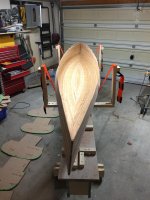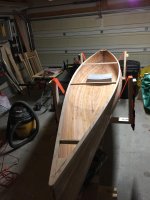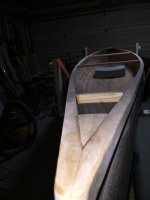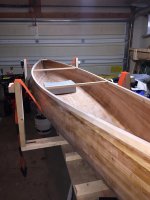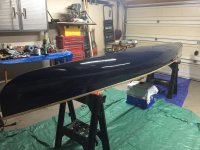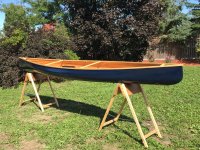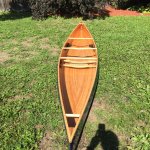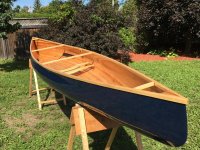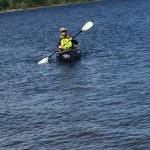Hi all. New to this forum and also new to canoe building. Been a lot of fun so far - started this in mid July with a handful of 16 foot decking boards from Home Depot and just finished glassing the outside and flipped it today to start on the interior. It is a 15 foot Ashes Solo Day, with 3/16 strips (hope my photo attachment worked). Have a single external layer of 6 ounce glass with three additional layers at each stem. The fibreglassing was semi-successful, in that it is solid but I wound up with a lot of streaks from amateurish use of a squeegee. Did a lot of sanding but now down to where I can see the cloth in places with some streaks stil remaining. I won't go any further, and will decide later whether to clear varnish or just paint the exterior, which I would be fine with.
I want to use this primarily for light tripping (2-3 nights, small lakes and calm rivers). Lightweight is a priority, but it also needs to be able to take some limited abuse. Right now the bare, partially fibreglassed hull weighs 22.5 pounds. My goal is as close to 30 pounds as I can get, but anything up to to
35 would be good. So assuming two pounds or so for the remaining non discretionary fibreglass I have about a ten pound maximum budget for all the fittings.
I have been reading this and other forums and have found some interesting ideas like cedar gunnels, composite hockey stick shafts for thwarts, strap yoke, etc. These all sound pretty promising but would appreciate any thoughts members here might have on these or other options to help me hit my 10 pound challenge. I have some budget but not unlimited, and don't have experience with or access to (in my mind at least) more exotic things like vacuum lamination equipment. I will have just one thwart, a small handle at each end, and no or very tiny decks (but flotation chambers would be nice). No real ideas on the seat, but leaning towards something floor mounted and low, but still an actual seat and not a dry sack or something - I plan to use a double bladed paddle, at least at this stage.
Anyway, that's my 10 pound challenge. Sorry if this post is too wide open, but any help or advice greatly appreciated (including whether any of you think I am being naive or reckless here, which given my total absence of experience in building a canoe could very well be the case). Thanks, and all the best.
I want to use this primarily for light tripping (2-3 nights, small lakes and calm rivers). Lightweight is a priority, but it also needs to be able to take some limited abuse. Right now the bare, partially fibreglassed hull weighs 22.5 pounds. My goal is as close to 30 pounds as I can get, but anything up to to
35 would be good. So assuming two pounds or so for the remaining non discretionary fibreglass I have about a ten pound maximum budget for all the fittings.
I have been reading this and other forums and have found some interesting ideas like cedar gunnels, composite hockey stick shafts for thwarts, strap yoke, etc. These all sound pretty promising but would appreciate any thoughts members here might have on these or other options to help me hit my 10 pound challenge. I have some budget but not unlimited, and don't have experience with or access to (in my mind at least) more exotic things like vacuum lamination equipment. I will have just one thwart, a small handle at each end, and no or very tiny decks (but flotation chambers would be nice). No real ideas on the seat, but leaning towards something floor mounted and low, but still an actual seat and not a dry sack or something - I plan to use a double bladed paddle, at least at this stage.
Anyway, that's my 10 pound challenge. Sorry if this post is too wide open, but any help or advice greatly appreciated (including whether any of you think I am being naive or reckless here, which given my total absence of experience in building a canoe could very well be the case). Thanks, and all the best.

